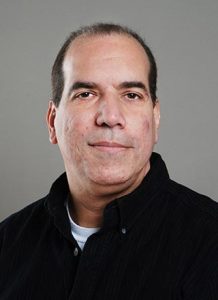January 27, 2021

Beef producers in the future could have a more precise way to determine the productivity of their cattle, thanks to a collaboration between Mizzou Engineering and the College of Agriculture, Food and Natural Resources (CAFNR).
“The goal is to maximize intake versus the output such as meat production,” said Guilherme DeSouza. “From an engineering point of view, we want to optimize the process.”
DeSouza is an associate professor of electrical engineering and computer science (EECS). He is working with Jared Decker, an associate professor for CAFNR. Decker recently received a $500,000 grant from the U.S. Department of Agriculture’s National Institute of Food and Agriculture for the work.
The project aims to provide a better understanding of how a herd’s environment and management impact productivity, Decker said. Researchers will predict factors such as a cow’s size—surface area to volume ratio—skeletal structure, fat resources and hair coat using 3-D image data. Further, they will create DNA predictions of these traits. This is important for successful beef production, which relies on continual reproduction.

High-Tech Imaging
To analyze those characteristics, DeSouza will use high-tech cameras to capture images of cows using specialized cattle chutes. The chutes will include sensors that create 3D models and thermal images of the animals.
“The idea is to study the area and volume of an animal as an indication of efficiency in feeding and how much energy is coming out in heat or used for the animal to grow,” DeSouza said. “The problem is that some animals have to consume more food just to keep warm. We want to optimize the process so the right amount of feed produces an animal that can give back the most.”
The team will also test the impact of location of a herd, specifically looking into Bergmann’s Rule. That’s an evolutionary principal that states larger animals live at higher latitudes.
“As animals move further from the equator, they get larger,” Decker said. “Is that because of the physics of heat retention—the smaller surface-to-volume ratio retains heat better? Or is it because of the nutritional availability. There are more nutrients, so animals are able to use those resources to grow faster and better adapt to the environment. We’ll be able to test those rules with direct measurements of surface area and volume.”
Ultimately, the project could lead to the availability of 3D scanning instruments for farmers. Decker envisions small systems set up on individual farms and ranches that could provide information to help producers better manage their herds.
“All of the questions and answers this study is going to provide will guide beef producers and help them choose their animals and how to feed their animals according to region,” DeSouza said.
A Catalyst for Collaboration
The research collaboration came about following a day-long idea lab on campus in 2019. Chi-Ren Shyu, director of the MU Institute for Data Science & Informatics (MUIDSI) and an EECS professor, co-hosted the event to promote cross-campus brainstorming. Rob Kallenbach, CAFNR associate dean, and Susan Renoe from the Office of Research, also co-hosted.
“MUIDSI has organized multiple mini labs to bring faculty of all backgrounds to tackle some important research issues,” Shyu said. “In the summer of 2019, we brought engineering and CAFNR together to talk about applying artificial intelligence into agricultural settings.”
And it highlights the fact that engineering—especially computer engineering—is found in every industry, DeSouza said.
“I often challenge my students to find one profession where computer science is not important,” he said. “Who would have thought cows had anything to do with engineering?”
That’s why Shyu is committed to bringing multiple disciplines together.
“Engineers can offer a lot of help with real-world problems in agriculture, medicine and social sciences,” he said. “I can see engineers everywhere. It plays an important role in many broad areas, some of which just haven’t been discovered yet.”